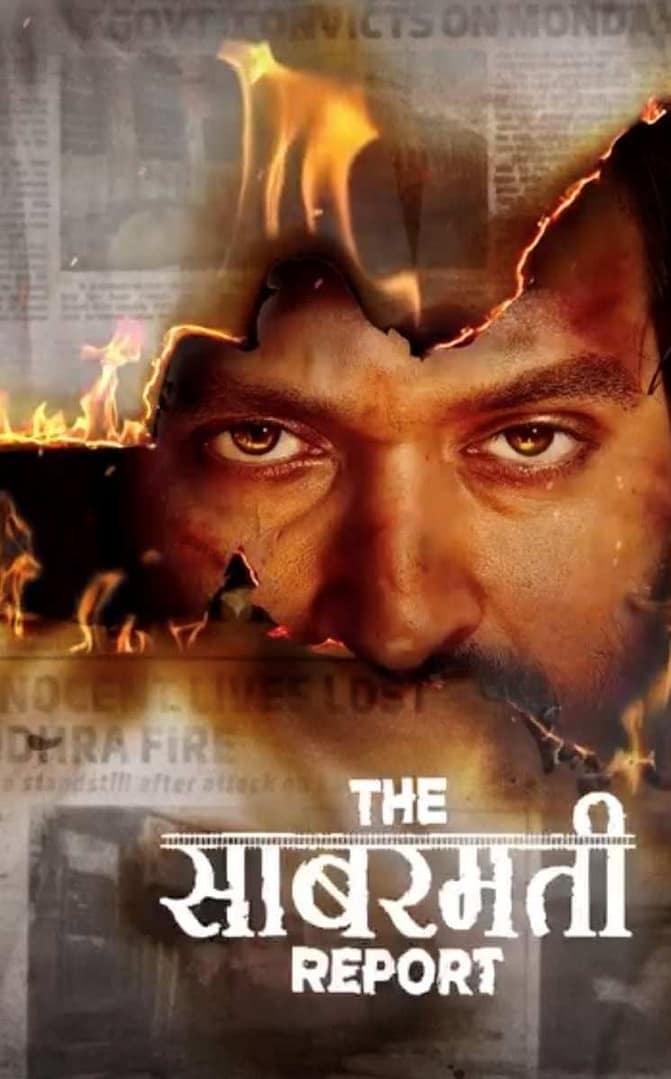Sabarmati Report is a 2024
Hindi political drama film by Dheeraj Sarna, revolving around the 2002 Godhra train burning incident. As the new journalist Vikrant Massey tries to dig up the real reasons behind the incident and media cover-ups, the story takes a turn of reality and truth. The movie was mixed, with praise for strong performances but slammed for weak writing and predictability. It was declared tax-free in Uttar Pradesh and other states, hoping viewership would be enhanced as the film apparently carried a controversial subject matter. As of now, it has grossed about ₹13.75 crore at the box office.
This film is based on the real facts about the 2002 Godhra train burning incident, which killed 59 persons and caused huge riots in Gujarat. The film explores the information in a dramatic manner with regard to the various kinds of truth, the story devised by the media, and the political manipulation over the tragedy.
The story also brings out the conflicting testimony by different inquiries, like the Nanavati-Mehta Commission, whose report claimed that the fire was most probably started from inside the train, as opposed to the initial report of an attack on the train. The film gives importance to the fact that this has been a very politicised issue and continues to be a sensitive issue in Indian society.
#How does the film characterise the role of the media in the Godhra train burning incident?
The film, the Sabarmati Report, depicts the role of the media as an inciting force in the burning train of Godhra. It reveals that journalists were partners in designing narratives to suit political tastes that denied the reality. The sacked journalist in the film resents this inconvenience for attempting to expose reality behind the tragedy, and this paradox between the elite English-language media and vernacular reporting is the subject matter of the film. The story highlights the distortions of media narratives, projecting fabricated stories to the audience, misleading them on the issue’s real nature.
#How does the movie depict the situation after the Godhra train burning case happened?
The Sabarmati Report deals with the consequences after the Godhra train burning incident by exposing the widespread communal violence that occurred in Gujarat, claiming more than 1,000 lives, mostly from Muslim communities. The film portrays the chaos and societal upheaval following the tragedy, emphasising how political narratives shaped public perception and response. It highlights the complexities of investigations and varying accounts regarding the incident’s causes, aiming to challenge established narratives and reveal deeper truths about the communal tensions that ensued.
READ ALSO: 15 Best places in Europe for a perfect family trip
READ ALSO: Top 15 best things to do in Seattle (2024)
#What are the main controversies addressed in the film?
The Sabarmati Report addresses several controversies surrounding the Godhra train burning incident:
-Media Manipulation: It criticizes the manner in which media stories were constructed to facilitate political causes, often distorted and communalized.
-Political Accountability: It provokes discussion on whether there was any role of the state or its machinery in reacting to the violence, with questions about negligence or complicity.
-Communal Violence: The depiction of the aftermath throws light on the severe divisions between the communities and the violence, giving rise to discussions on religious identity and societal polarisation.
-These themes inform the controversy that surrounded the film since it broke narrative conveniences and political sensitivities regarding the happenings.
#Summary of The Sabarmati Report
The film is a Hindi political drama of 2024 directed by Dheeraj Sarna. The film revolves around the pivotal 2002 Godhra train burning incident, which brought about widespread communal violence in Gujarat.
#Plot Summary
The storyline is of a young journalist, Vikrant Massey, who is researching the mystery behind the burning train and the present political agitations. As he digs into it, he faces the difficult genre of media manipulation, the proof of false design, and the furore from social unrest. His journey depicts how hard it is to reveal truth in journalism and how much those narratives can play with people’s perception.
#Key Themes
-Media Manipulation: The film critiques how media outlets shaped narratives to suit political interests, often distorting facts and inciting communal tensions.
-Political Accountability: It questions the role of government and law enforcement in the aftermath of the incident, suggesting negligence or complicity in the violence that ensued.
-Mass Violence: The depiction of the social chaos after the train burning reveals a definite kind of communitarian fissures and sparks controversy over religious identity and polarization.
#Review
The movie has received mixed reviews. Its performances were appreciated while its story and predictability were criticized. It was declared tax-free in several states as its topic was quite controversial.
Overall, The Sabarmati Report is a thought-provoking exploration of a significant historical event, tracing the interplay between media, politics, and society.
#Film Visuals in the Narrative.
The film The Sabarmati Report utilizes different visual elements to convey its message effectively:
-Color Scheme: The application of particular color schemes has the effect of emotional impact; dark tones often represent tension and hopelessness, whereas warmer colors may indicate hope or even resolution of conflict.
-Cinematography: Effective use of camera angles and movements may evoke a sense of intimacy or isolation that imparts how viewers understand characters and their problems. For example, low-angle shots may portray power dynamics, whereas close-ups reveal emotional depth .
-Visual Imagery: Objects and milieu are endowed with symbolic meanings that reflect the film’s themes. For instance, prevailing motifs can symbolize social cleavages or the quest for truth.
These ploys are integrated to create a riveting storyline that draws the audience on myriad dimensions.
#What are the primary controversies associated with the Godhra train burning case?
-The primary controversies related to the Godhra train burning case include:
About the disputed origin of the fire: The conclusions drawn by the investigations are contradictory. The Gujarat government claimed that it started as a result of the action of a Muslim mob, whereas others claim that it started as an accident and probably from inside the train.
-Political Maneuver: The incident has been politicized, as different parties use the findings to prove their respective narratives. The BJP claimed it was an act of terrorism, whereas the Congress claimed it was a stagemanaged incident to stir up violence.
-Judicial Controversies: Various commissions investigated the incident, leading to differing conclusions. The Nanavati Commission labeled it a conspiracy, while the Banerjee Commission termed it an accident, which was later deemed unconstitutional by the Supreme Court.
-Communal Violence: The aftermath saw extensive riots resulting in over 1,000 deaths, predominantly among Muslims, raising questions about state complicity and response to violence.
These controversies mark some of the ongoing strains in Indian society relating to communal relations and political accountability.
#What were the significant differences between the Gujarat State Enquiry Commission and the findings of the central enquiry commission?
-The significant differences between the Gujarat State Inquiry Commission (Nanavati-Mehta Commission) and the findings of the central inquiry commission in relation to the Godhra train burning incident are as follows:
#Cause of the Fire:
Nanavati-Mehta Commission: Determined that the fire was purely an act of premeditated arson, not an accident, and cleared Gujarat Chief Minister Narendra Modi and his government of any role or omission.
Central Commission: The central investigation undertaken by the Banerjee Commission indicated that the fire was accidental, originating from within the train, thus countering the version of a “managed” attack.
#Political Implications:
Nanavati-Mehta Commission: Its verdicts were reportedly pro-BJP in nature, and because of the alleged linkages between the members of the Nanavati-Mehta commission with political leaders, it was accused of partiality and political maneuvering.
Central Commission: The Banerjee Commission verdict was more neutral and looked at the bigger questions about communal violence and government accountability without being perceived as having any allegiance to any of the political parties.
#Public Response:
-Nanavati-Mehta Commission: Received mixed reactions; welcomed by the BJP supporters but protested and criticized to a great extent by the opposition parties and by human rights organizations. The reason was of suspected state complicity into the violence that ensued after the incident.
-Central Commission: In contrast, its findings were less openly politically charged and instead tended towards a more fuller understanding of the events without being tied to specific political narratives.
-These differences reflect the controversy-mired process in the investigations about the Godhra incident and its long-term aftermath on the communal relationships of India.
#How was public perception when the Gujarat state enquiry commission rendered its findings?
-Public perceptions of the findings of the Gujarat state inquiry commission-Nanavati-Mehta Commission were divided and highly charged.
-Opposition Parties Criticism: The Indian National Congress and the Communist Party of India (Marxist) protested against the exoneration of the Gujarat government by the commission, suggesting that its conclusions were politically motivated at a time close to elections. They alleged it strengthened the communal prejudices and did not take into account evidence of government complicity in the violence following the burning of the train.
-Academic Skepticism: Scholars, including Christophe Jaffrelot, criticized the commission for hastily supporting the conspiracy theory of arson while overlooking substantial evidence that could implicate state actors in the violence. This skepticism reflected broader concerns about the commission’s impartiality and thoroughness.
-Support from BJP: The BJP found solace in the report as a vindication of the party’s stance on the incident, terming it a political defeat for the Congress party. They dismissed other reports as the attempt to sway public opinion against them.
In general, the findings deeply agitated the specter of responsibility and truth in India, pointing to the Indian society’s huge gap in public opinion due to the incident as well as its aftermath.



